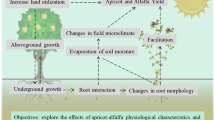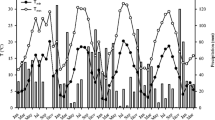Abstract
It has been reported that root characteristics and canopy structure in an agroforestry system directly change the availability of underground and aboveground resources and climatic conditions and seriously affect crop growth and yield (Dufour et al. in J Agron Crop Sci 199: 217–227, 2013; Bouttier et al. in Agroforest Syst 88: 693–706, 2016; Farooq et al. in Appl Ecol Env Res 17: 3553-3566, 2019). An experiment was conducted in northwest China to explore the distribution and characteristics of root systems for alfalfa grown in a poplar/alfalfa silvopastoral system. Field sampling was conducted every 15 days in a 3-yr-old alfalfa + 7-yr-old poplar silvopastoral system, a 3-yr-old sole-alfalfa system, and a 7-yr-old sole-poplar system. The results showed that intercropping reduced the RLD of alfalfa, while the FSRL of intercropped alfalfa was higher than that of sole-cropped alfalfa. In terms of the agronomic traits of alfalfa (plant height, leaf area index, leaf-stem ratio, growth rate), intercropping traits were significantly lower than sole-cropped alfalfa, and the total hay yield during intercropping was 55.27% lower than that of sole-cropped alfalfa. In terms of field microclimate, the dew point temperature and wind speed of sole-cropped alfalfa were 70.68% and 93.83% higher than that of intercropping, but the air humidity of sole-cropped alfalfa was 13.49% lower than that of intercropping, and there was no significant difference in air temperature. The crude protein (CP), crude fat (CF), and relative feed value (RFV) of intercropping alfalfa were 17.78%, 12.33%, and 17.26% higher than sole-cropped alfalfa, respectively. Although the agronomic traits and yield of alfalfa decreased with intercropping, intercropping could improve the microclimate and the quality of alfalfa significantly. The land equivalent ratio (LER = 1.42) in the poplar/alfalfa silvopastoral system was > 1, indicated that the system in advantageous.






Similar content being viewed by others
References
Aurélie Q, Patricia B, Lydie D, Jacques W, Christian D (2016) Effects of walnut trees on biological nitrogen fixation and yield of intercropped alfalfa in a Mediterranean agroforestry system. Eur J Agron 84:35–46. https://doi.org/10.1016/j.eja.2016.12.001
Bao WY, Zhao ML, An HB, Li BZ, Xu J, Zhao B, Gao XJ (2005) Effects of cutting on growth and yield of different alfalfa varieties. J Northwest Sci-Tech Univ Agric For Nat Sci Ed. 43:65–71. https://doi.org/10.13207/j.cnki.jnwafu.2015.02.007
Bayala J, Teklehaimanot Z, Ouedraogo SJ (2004) Fine root distribution of pruned trees and associated crops in a parkland system in Burkina Faso. Agrofor Syst 60:13–26. https://doi.org/10.1023/B:AGFO.0000009401.96309.12
Bouttier LA, Paquette A, Alain M, David R, Alain O, Alain C (2014) Vertical root separation and light interception in a temperate tree-based inter-cropping system of Eastern Canada. Agroforest Syst 88:693–706. https://doi.org/10.1007/s10457-014-9721-6
Burton AJ, Pregitzer KS, Hendrick RL (2000) Relationships between fine root dynamics and nitrogen availability in Michigan northern hardwood forests. Oecologia 125:389–399. https://doi.org/10.1007/s004420000455
Chen JM, Wan HE, Wang J (2005) Alfalfa growth and its relation with soil water status in loess hilly and gully region. Chin J Appl Ecol 16:435–438
Conklin-Brittain NL, Dierenfeld ES, Wrangham RW, Norconk M, Silver SC (1999) Chemical protein analysis: a comparison of Kjeldahl crude protein and total ninhydrin protein from wild, tropical vegetation. J Chem Ecol 25:2601–2622. https://doi.org/10.1023/A:1020835120701
Corl B, Rhoads M, Harrell RJ, Blikslager AT, Phillips OT, Gatlin LA, Niu XM, Odle J (2005) Rotaviral enteritis stimulates ribosomal p70 s6 kinase and increases intestinal protein synthesis in neonatal pigs. Fed Am Soc Exp Bio J 19:976–976
Eissenstat DM, Yanai RD (1997) The ecology of root lifespan. Adv Ecol Res Acad Press 27:1–60. https://doi.org/10.1016/S0065-2504(08)60005-7
FAO (2013) The State of Food and Agriculture 2013 −Food Systems for Better Nutrition.
Farooq T, Ma X, Rashid M, Wu W, Xu J, Tarin M, He Z, Wu P (2019b) Impact of stand density on soil quality in Chinese Fir (Cunninghamia Lanceolata) monoculture. Appl Ecol Env Res 17(2):3553–3566
Farooq TH, Wu W, Tigabu M, Ma X, He Z, Rashid MH, Gilani MM, Wu P (2019) Growth, biomass production and root development of Chinese fir in relation to initial planting density. Forests 10(3):236. https://doi.org/10.3390/f10030236
Gan YW, Li L, Li LH, Zhang W, Wang BJ (2015) Spatial distribution of root diameter and specific root length in walnut/wheat agroforestry system. Acta Agr Bor-Occid Sin 24:56–63. https://doi.org/10.7606/j.issn.1004-1389.2015.05.010
Jin WB, Zhang FB (2014) The response of growth characteristics and quality of alfalfa to different cutting intensity. Northen Hort 21:72–77
Jose S (2009) Agroforestry for ecosystem services and environmental benefits: an overview. Agroforest Syst 76:1–10. https://doi.org/10.1007/s10457-009-9229-7
Jose J, Dollinger J (2019) Silvopasture: a sustainable livestock production system. Agroforest Syst 93:1–9. https://doi.org/10.1007/s10457-019-00366-8
Jose S, Gillespie AR, Seifert JR, Mengel DB, Pope PE (2000) Defining competition vectors in a temperate alley cropping system in the mid-western USA. 3. Competition for nitrogen and litter decomposition dynamics. Agroforest Syst 48:61–77. https://doi.org/10.1023/A:1006241406462
Kajembe J, Lupala I, Kajembe G (2016) The role of selected agroforestry trees in temperature adaptation on Coffea Arabica: a case study of the Moshi district, Tanzania. In: Lal R, Kraybill D, Hansen DO, Singh BR, Mosogoya T, Eik LO (eds) Climate change multidimensional sustain African agriculture. Springer, Cham, pp 553–566. https://doi.org/10.1007/978-3-319-41238-2_29
Kuyah S, Öborn I, Jonsson M (2016) Trees in agricultural landscapes enhance provision of ecosystem services in Sub-Saharan Africa. Int J Biodivers Sci Ecosyst Serv Manag 12:255–273. https://doi.org/10.1080/21513732.2016.1214178
Langenberger G, Cadisch G, Martin K, Min S, Waibel H (2017) Rubber intercropping: a viable concept for the 21st century? Agroforest Syst 91:577–596. https://doi.org/10.1007/s10457-016-9961-8
László B, Péter B (2013) Nuttition: Determination of Neutral-detergent fiber (NDF) and Acid-detergent fiber (ADF) (Van soest-method). Debrecen: University of Debrecen. https://regi.tankonyvtar.hu/hu
Li L, Sun JH, Zhang FS, Li XL, Yang SC, Zdenko R (2001) Wheat/maize or wheat/soybean strip intercroping. Field Crop Res 71:123–137. https://doi.org/10.1016/S0378-4290(01)00156-3
Liu YH (2006) Study on the relationship between growth and yield formation of alfalfa and meteorological conditions. J Northwest Sci-Tech Univ Agric for. https://doi.org/10.1023/B:PLSO.0000047750.80654.d5
Liu DX, Liu GH, Yang ZM (2015) The effects of planting and harvesting factors on hay yield and stem-leaf ratio of Medicago sativa. Acta Pratac Sin 24(03):48–57. https://doi.org/10.11686/cyxb20150305
Lynch J (1995) Root architecture and plant productivity. Plant Phys 109:7–13. https://doi.org/10.1104/pp.109.1.7
McCallum MH, Peoples MB, Connor DJ (1999) Contributions of nitrogen by field pea (Pisum sativum L.) in a continuous cropping sequence compared with a lucerne (Medicago sativa L.)-based pasture ley in the Victorian Wimmera. Aus J Agr Res 51(1):13–22
Miao XR, Sun YM, Yu L, Ma CH, Zhang QB (2019) Effects of nitrogen and phosphorus interaction on the production performance and nutrient quality of alfalfa under drip irrigation of different stubble. Pratac Sci 28:55–66. https://doi.org/10.11686/cyxb2018566
Pei ZP, Yu LL, Wang YJ, Li YF, Liu T, Chang XH (2014) Comparative research on drought resistance of 4 plant species in ecological regeneration on arid area. J Arid Land Resour Env 28:204–208. https://doi.org/10.13448/j.cnki.jalre.2014.03.026
Peng XB, Cai J, Jiang ZM, Li YF, Liu Y, Chang XH (2009) Effects of light energy competition on agroforestry ecosystem productivity. Acta Ecol Sin 29:545–552
Pregitzer KS (2003) Woody plants, carbon allocation and fine roots. New Phytolo 158:421–423. https://doi.org/10.1046/j.1469-8137.2003.00766.x
Pregitzer KS, King JS, Burton AJ, King JS, Burton AJ, Brown SE (2000) Responses of tree fine roots to temperature. New Phytol 147:105–115. https://doi.org/10.1046/j.1469-8137.2000.00689.x
Pregitzer KS, Deforest JL, Burton AJ, Allen MF, Ruess RW, Hendrick RL (2002) Fine root architecture of nine North American trees. Ecol Monogr 72:293–309. https://doi.org/10.1890/0012-9615(2002)072[0293:FRAONN]2.0.CO;2
Querne A, Battie-Laclau P, Dufour L, Wery J, Dupraz C (2017) Effects of walnut trees on biological nitrogen fixation and yield of intercropped alfalfa in a Mediterranean agroforestry system. Eur J Agron 84:35–46. https://doi.org/10.1016/j.eja.2016.12.001
Shao ZQ, Wang XY, Gao Q, Zhang HL, Yu HL, Wang Y, Zhang JJ, Nasar J, Gao YZ (2020) Root contact between maize and alfalfa facilitates nitrogen transfer and uptake using techniques of foliar 15N-labeling. Agron 10(3):360–378. https://doi.org/10.3390/agronomy10030360
Shem K, Cory W, Mattias J, Sileshi GW, Öborn I, Muthuri CW, Luedeling E (2019) Agroforestry delivers a win-win solution for ecosystem services in sub-Saharan Africa. A Meta-Anal Agron Sustain Dev 39:1–18. https://doi.org/10.1007/s13593-019-0589-8
Tang CY, Wei ZW, Jiang Z, Yan YF, Zhang Q, Wu JL (2020) Effects of row ratio on yield and quality of different intercropping modes. Acta Agrestia Sin 28:214–220. https://doi.org/10.11733/j.issn.1007-0435.2020.01.025
Upson MA, Burgess PJ (2013) Soil organic carbon and root distribution in a temperate arable agroforestry system. Plant Soil 373:43–58. https://doi.org/10.1007/s11104-013-1733-x
Wang GL, Jia CL, Zhou YL, Yang QL, Sheng YB, Cui FM (2010) Preliminary study on effect of shading on the growth and yield of Medicago sativa. Pratal Sci 27:69–73
Wang BJ, Zhang W, Ahanbieke P, Gan YW, Xu WL, Li LH, Christie P, Li L (2014) Interspecific interactions alter root length density, root diameter and specific root length in jujube/wheat agroforestry systems. Agroforest Syst 88(5):835–850. https://doi.org/10.1007/s10457-014-9729-y
Wang XY, Yang T, Shen L, Zhang WL, Wan SM, Zhang W, Li LH (2021) Formation of factors influencing cotton yield in jujube-cotton intercropping systems in Xinjiang, China. Agroforest Syst 95:177–189. https://doi.org/10.1007/s10457-020-00571-w
Wassie M, Zhang WH, Zhang Q, Ji K, Cao LW, Chen L (2020) Exogenous salicylic acid ameliorates heat-stress induced damages and improves growth and photosynthetic efficiency in alfalfa (Medicago sativa L.). Ecotox Environ Safe 191:110–206. https://doi.org/10.1016/j.ecoenv.2020.110206
Wu J (2008) Analysis of leaf growth dynamics and environmental factors of alfalfa. J Northwest Sci-Tech Univ Agric For. https://xueshu.baidu.com/usercenter/paper/show?paperid=491d88c80b549a34f5b9e7d58cfad5db&site=xueshu_se
Wu P, Wang G, Farooq TH, Li Q, Zou X (2017) Ma X (2017) Low phosphorus and competition affect Chinese fir cutting growth and root organic acid content: does neighboring root activity aggravate P nutrient deficiency? J Soils Sediments 17(12):2775–2785. https://doi.org/10.1007/s11368-017-1852-8
Xu CY (2013) Dynamic research on shallow groundwater and soil moisture of Shihezi agricultural areas. Chang’an Univ. https://xueshu.baidu.com/usercenter/paper/show?paperid=7fa587fd9a219bb2c8a56df617c96891&site=xueshu_se
Yang T, Zhu Y, Duan ZP, Lu WH, Zhang FF, Wan SM, Xu WX, Zhang W, Li LH (2019) Root distribution and productivity in a poplar tree + alfalfa silvopastoral system in northwest China’s Xinjiang Province. Agroforest Syst 94(3):997–1010. https://doi.org/10.1007/s10457-019-00466-5
Yang T, Ma CH, Lu WH, Wang SM, Li LH, Zhang W (2021) Microclimate, crop quality, productivity, and revenue in two types of agroforestry systems in drylands of Xinjiang, northwest China. Eur J Agron 124:1–10. https://doi.org/10.1016/j.eja.2021.126245
Zamora DS, Jose S, Nair PKR (2007) Morphological plasticity of cotton roots in response to interspecific competition with pecan in an alley cropping system in the southern United States. Agroforest Syst 69:107–116. https://doi.org/10.1007/s10457-006-9022-9
Zhang YQ, Zhang N, Li YJ, Su LL, Xu WX, Peng JL, Hu CH (2015) Impacts of drip irrigation amount on physiological characteristic of summer soybean and field microclimate. Chin J Agrometeorol 36(5):586–593. https://doi.org/10.3969/j.issn.1000-6362.2015.05.008
Zhang N, Zhang YQ, Xu WX, Xu WX, Wu NP, Wu PJ, Cheng XF (2015) Effect of different drip irrigation amounts on microclimate and yield of winter wheat. Chin J Eco Agr 24(1):64–73. https://doi.org/10.13930/j.cnki.cjea.150678
Zhao YJ, Liu XJ, Tong CC, Wu Y (2020) Effect of root interaction on nodulation and nitrogen fixation ability of alfalfa in the simulated alfalfa/triticale intercropping in pots. Sci Rep 10:4269–4280. https://doi.org/10.1038/s41598-020-61234-5
Zheng W (2019) Effect and mechanism of cover crop combined with different fertilization on apple yield and quality as well as soil water and nutrient use efficiency. J Northwest Sci-Tech Univ Agric For. https://xueshu.baidu.com/usercenter/paper/show?paperid=1v2408n0sg5p0m80pn5y0p30wg072012&site=xueshu_se&hitarticle=1
Zheng CH, Wang RS, Zhou X, Li CN, Dou XY (2021) Effects of mulch and irrigation regimes on water distribution and root competition in an apple-soybean intercropping system in Loess Plateau, China. Agr Water Manage 246:1–13. https://doi.org/10.1016/j.agwat.2020.106656
Acknowledgements
This work was financially supported by the Innovation and Development Project of Shihezi University (CXFZ202008), by the National Natural Science Foundation of China (Project Nos. 31460335 and 31560376).
Author information
Authors and Affiliations
Corresponding authors
Additional information
Publisher's Note
Springer Nature remains neutral with regard to jurisdictional claims in published maps and institutional affiliations.
Rights and permissions
About this article
Cite this article
Dai, Y.S., Yang, T., Shen, L. et al. Root growth, distribution, and physiological characteristics of alfalfa in a poplar/alfalfa silvopastoral system compared to sole-cropping in northwest Xinjiang, China. Agroforest Syst 95, 1137–1153 (2021). https://doi.org/10.1007/s10457-021-00639-1
Received:
Accepted:
Published:
Issue Date:
DOI: https://doi.org/10.1007/s10457-021-00639-1




